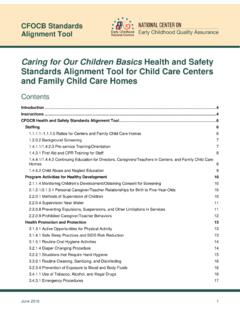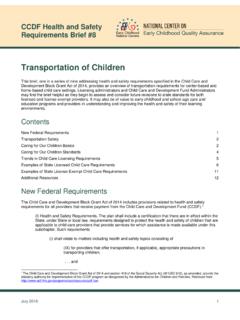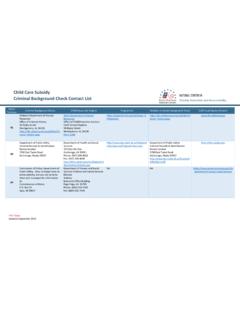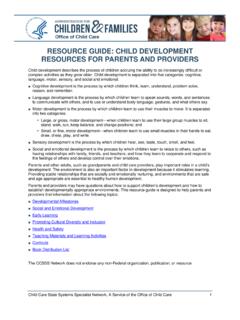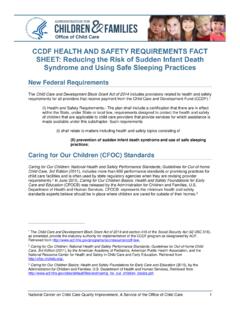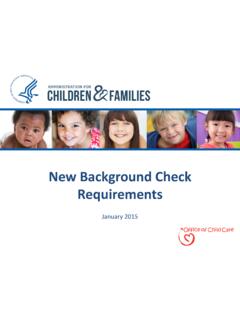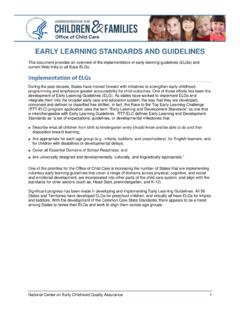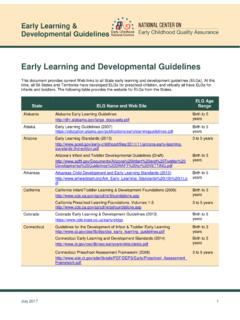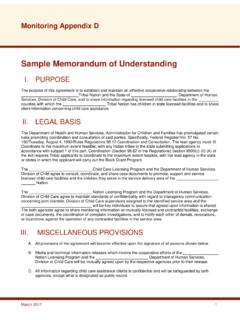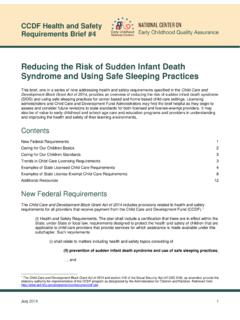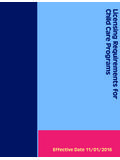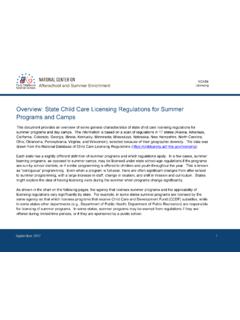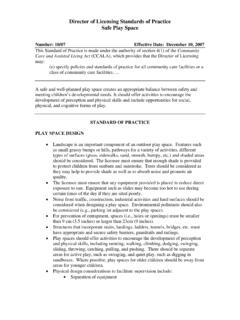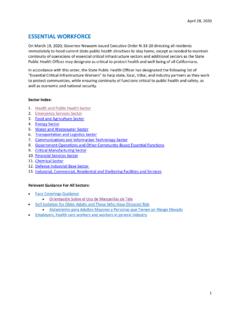Transcription of State Regulatory Requirements for Emergency Preparedness ...
1 State Regulatory Requirements FOR Emergency Preparedness PLANNING This Document was originally developed under a previous contract with the Office of child care . The following are excerpts from State child care licensing regulations about Emergency Preparedness planning and response. These examples do not include all States that have Emergency Preparedness Requirements , but are meant to represent a range of approaches that States have taken to ensure that providers are prepared for emergencies. This information was compiled from the child care licensing regulations posted on the National Resource Center for Health and Safety in child care and Early Education s Web site at State licensing Regulations Delaware Rules for Early care and Education and school -A ge Centers (1/1/2007) Emergency PLANNING 276.
2 A licensee shall have a written Emergency plan describing procedures for both natural and man-made disasters for such situations as a fire, flood, earthquake, extreme weather conditions, power failure or utility disruptions, chemical or toxic spills, bomb threat, or terrorist attack. A. The Emergency plan shall include procedures for training staff about disaster Preparedness , staff s specific responsibilities during a disaster, accounting for all children and staff, relocation process (if appropriate), and contacting appropriate Emergency response agencies and parents/guardians. 277.
3 A licensee shall have a written evacuation plan of the Center posted in each room the children use. A. Monthly evacuation drills shall be practiced from all exit locations at varied times of the day and during varied activities including nap time. Each drill shall be documented and include information on the date and time of day of the drill, the number of children and staff members who participated, and the total amount of time necessary to evacuate the Center. 278. A licensee shall develop a written plan for procedures in the event that children and staff must remain at the Center for an extended period due to a natural or man-made disaster.
4 A. This plan shall include a list of Emergency supplies for the care of children and procedures for feeding children and staff during the extended stay at the Center. Iowa Chapter 109 child care Centers, in Human Services Department [441], in Iowa Administrative Code (9/4/2013) (15) Emergency plans. a. The center shall have written Emergency plans for responding to fire, tornado, flood (if area is susceptible to flood), intruders within the center, intoxicated parents and lost or abducted children. In addition, the center shall have guidelines for responding or evacuating in case of child care State Systems Specialist Network, A Service of the Office of child care 1 State Regulatory Requirements for Emergency Preparedness Planning November 2014 blizzards, power failures, bomb threats, chemical spills, earthquakes, or other disasters that could create structural damage to the center or pose health hazards.
5 If the center is located within a ten-mile radius of a nuclear power plant or research facility, the center shall also have plans for nuclear evacuations. Emergency plans shall include written procedures including plans for transporting children and notifying parents, Emergency telephone numbers, diagrams, and specific considerations for immobile children. b. Emergency instructions, telephone numbers, and diagrams for fire, tornado, and flood (if area is susceptible to floods) shall be visibly posted by all program and outdoor exits. Emergency plan procedures shall be practiced and documented at least once a month for fire and for tornado.
6 Records on the practice of fire and tornado drills shall be maintained for the current and previous year. c. The center shall develop procedures for annual staff training on these Emergency plans and shall include information on responding to fire, tornadoes, intruders, intoxicated parents and lost or abducted children in the orientation provided to new employees. d. The center shall conduct a daily check to ensure that all exits are unobstructed. Maryland Subtitle 16: child care Centers, in Title 13A: State Board of Education, in Annotated Code of Maryland (4/14/2014) COMAR Safety.
7 01 Emergency Safety Requirements . A. Emergency and Disaster Plan. (1) At least one center employee shall: (a) Complete Emergency Preparedness training that is approved by the office; and (b) As part of the approved Emergency Preparedness training, prepare a written Emergency and disaster plan for the center. (2) The operator shall maintain the Emergency and disaster plan prepared in accordance with A(1)(b) of this regulation. (3) The Emergency and disaster plan shall: (a) Establish procedures for: (i) Evacuating the center, including an evacuation route; (ii) Relocating staff and children to a designated safe site; (iii) Sheltering in place in the event that evacuation is not feasible; (iv) Notifying parents of children in care ; and (v) Addressing the individual needs of children, including children with special needs; (b) Contain: (i) The name of, and contact information for the local Emergency operations center; (ii) Assignment of staff responsibilities during an Emergency or disaster.
8 (iii) A list of local Emergency services numbers; and child care State Systems Specialist Network, A Service of the Office of child care 2 State Regulatory Requirements for Emergency Preparedness Planning November 2014 (iv) The radio station call sign and frequency for the local Emergency Alert System; (c) Be practiced by staff and children at least: (i) Once per month for fire evacuation; and (ii) Twice per year for other Emergency and disaster situations; and (d) Be updated at least annually. (4) A copy of the Emergency escape route floor plan shall be posted in each area and room in the center.
9 (5) Each employee shall be oriented to the contents of the written Emergency and disaster plan required at A(2) of this regulation. (6) In the event of a declared Emergency , the operator shall be prepared to respond as directed by the local Emergency management agency through sources of public information. (7) During an Emergency evacuation or practice, a staff member shall take attendance records out of the center and determine the presence of each child currently in attendance. B. If the child care center is included within a comprehensive Emergency and disaster plan, the center operator shall ensure that: (1) The comprehensive plan contents meet all Emergency and disaster plan Requirements set forth at A(2)(a) and (b) of this regulation; and (2) A copy of the comprehensive plan is available to all staff.
10 C. An operator shall post, immediately accessible to each telephone in the center, a notice stating the: (1) 9-1-1 Emergency telephone number to summon fire, police, and rescue services; (2) Center's name, address, and telephone number; (3) Telephone number of the protective services unit of the local department of social services; (4) Telephone number of a poison control center; (5) Name and telephone number of the local health department or a physician to consult about issues regarding health and illnesses; (6) Name and telephone number of the available adult as required by COMAR (3); and (7) Telephone number of the office.
